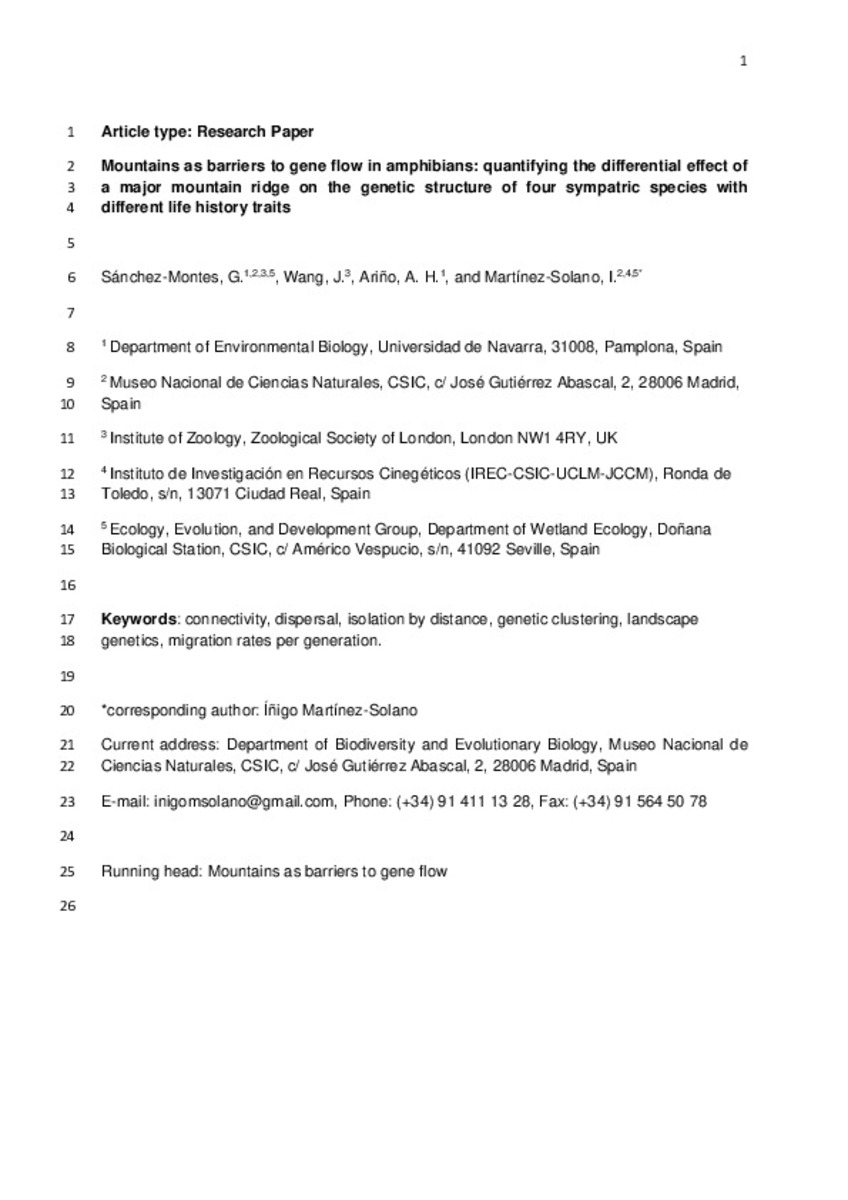Full metadata record
| DC Field | Value | Language |
|---|---|---|
| dc.creator | Sánchez-Montes, G. (Gregorio) | - |
| dc.creator | Wang, J. (Jinliang) | - |
| dc.creator | Ariño-Plana, A.H. (Arturo Hugo) | - |
| dc.creator | Martínez-Solano, I. (Íñigo) | - |
| dc.date.accessioned | 2024-02-09T08:49:42Z | - |
| dc.date.available | 2024-02-09T08:49:42Z | - |
| dc.date.issued | 2018 | - |
| dc.identifier.citation | Sánchez-Montes, G. (Gregorio); Wang, J. (Jinliang); Ariño-Plana, A.H. (Arturo Hugo); et al. "Mountains as barriers to gene flow in amphibians: Quantifying the differential effect of a major mountain ridge on the genetic structure of four sympatric species with different life history traits". Journal of Biogeography. 45 (2), 2018, 318 - 331 | es |
| dc.identifier.issn | 0305-0270 | - |
| dc.identifier.uri | https://hdl.handle.net/10171/68954 | - |
| dc.description.abstract | [Aim]: To test the role of mountains as barriers to gene flow in co-distributed taxa with different life history traits. [Location]: Sierra de Guadarrama, Central Spain. [Methods]: We used larval genotypes of four amphibian species (Epidalea calamita, Hyla molleri, Pelophylax perezi and Pelobates cultripes) sampled on northern and southern slopes of Sierra de Guadarrama to describe genetic structure with F, migration rates per generation, clustering algorithms and resistance by elevation surfaces. We also recorded individual displacement events as a proxy of dispersal potential during a seven-year monitoring project based on capture–mark–recapture (CMR). [Results]: All species travelled longer cumulative distances than those reported in the study area for P. cultripes (0.71 km). Individuals of E. calamita travelled up to 3.55 km, followed by H. molleri (2.84 km) and P. perezi (1.51 km). Pairwise F estimates showed lower overall connectivity in P. cultripes. Average migration rates per generation were low in all species, with exceptions in same-slope populations of H. molleri and P. cultripes. Clustering algorithms consistently recovered well-differentiated population groups of P. cultripes in northern versus southern slopes, but widely admixed areas were observed in the other species, especially near mountain passes. Resistance by elevation surfaces showed a strong barrier effect of Sierra de Guadarrama in P. cultripes and suggested a potential role of topography in the genetic structure of E. calamita and H. molleri. [Main conclusions]: Sierra de Guadarrama currently acts as a strong barrier to gene flow for P. cultripes and, to a lesser extent, for E. calamita, H. molleri and P. perezi. This differential effect can be partly explained by differences in life history traits, including dispersal potential. Our findings support the general role of the Central System as a key feature shaping population connectivity and genetic variation in amphibian communities. | - |
| dc.description.sponsorship | G.S.M. was funded by Asociación de Amigos de la Universidad de Navarra. This research was funded by grants CGL2008-04271-C02-01/BOS and CGL2011-28300 (Ministerio de Ciencia e Innovación, Ministerio de Economía y Competitividad, Spain, and FEDER) toI.M.S., who was supported by funding from the Spanish ‘Ramón y Cajal’(RYC-2007-01668) and ‘Severo Ochoa’ (SEV-2012-0262) programmes | - |
| dc.language.iso | eng | es_ES |
| dc.publisher | Wiley & Sons | es_ES |
| dc.rights | info:eu-repo/semantics/openAccess | es_ES |
| dc.subject | Materias Investigacion::Ciencias medioambientales | es_ES |
| dc.subject | Connectivity | es_ES |
| dc.subject | Dispersal | es_ES |
| dc.subject | Isolation by distance | es_ES |
| dc.subject | Genetic clustering | es_ES |
| dc.subject | Landscape17 genetics | es_ES |
| dc.title | Mountains as barriers to gene flow in amphibians: Quantifying the differential effect of a major mountain ridge on the genetic structure of four sympatric species with different life history traits | es_ES |
| dc.type | info:eu-repo/semantics/article | es_ES |
| dc.identifier.doi | 10.1111/jbi.13132 | - |
| dadun.citation.endingPage | 331 | es_ES |
| dadun.citation.number | 2 | es_ES |
| dadun.citation.publicationName | Journal of Biogeography | es_ES |
| dadun.citation.startingPage | 318 | es_ES |
| dadun.citation.volume | 45 | es_ES |
Files in This Item:
Statistics and impact
Items in Dadun are protected by copyright, with all rights reserved, unless otherwise indicated.






